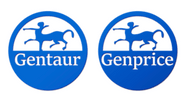Description
GHSR Antibody | 56-090 | Gentaur UK, US & Europe Distribution
Host: Rabbit
Reactivity: Human, Mouse
Homology: Predicted species reactivity based on immunogen sequence: Pig, Rabbit
Immunogen: This GHSR antibody is generated from rabbits immunized with a KLH conjugated synthetic peptide between 326-357 amino acids from the C-terminal region of human GHSR.
Research Area: Obesity, Neuroscience, Growth Factors
Tested Application: WB, IHC-P
Application: For IHC-P starting dilution is: 1:50~100
For WB starting dilution is: 1:1000
Specificiy: N/A
Positive Control 1: N/A
Positive Control 2: N/A
Positive Control 3: N/A
Positive Control 4: N/A
Positive Control 5: N/A
Positive Control 6: N/A
Molecular Weight: 41 kDa
Validation: N/A
Isoform: N/A
Purification: This antibody is purified through a protein A column, followed by peptide affinity purification.
Clonality: Polyclonal
Clone: N/A
Isotype: Rabbit Ig
Conjugate: Unconjugated
Physical State: Liquid
Buffer: Supplied in PBS with 0.09% (W/V) sodium azide.
Concentration: batch dependent
Storage Condition: Store at 4˚C for three months and -20˚C, stable for up to one year. As with all antibodies care should be taken to avoid repeated freeze thaw cycles. Antibodies should not be exposed to prolonged high temperatures.
Alternate Name: Growth hormone secretagogue receptor type 1, GHS-R, GH-releasing peptide receptor, GHRP, Ghrelin receptor, GHSR
User Note: Optimal dilutions for each application to be determined by the researcher.
BACKGROUND: This gene encodes a member of the G-protein coupled receptor family. The encoded protein may play a role in energy homeostasis and regulation of body weight. Two identified transcript variants are expressed in several tissues and are evolutionary conserved in fish and swine. One transcript, 1a, excises an intron and encodes the functional protein; this protein is the receptor for the Ghrelin ligand and defines a neuroendocrine pathway for growth hormone release. The second transcript (1b) retains the intron and does not function as a receptor for Ghrelin; however, it may function to attenuate activity of isoform 1a. Mutations in this gene are associated with autosomal idiopathic short stature.








![GHSR Antibody (C-term) [APR30861G] GHSR Antibody (C-term) [APR30861G]](https://cdn11.bigcommerce.com/s-1rdwiq712m/images/stencil/590x590/products/62004/62308/gentaur-genprice__26005.1661610467__29809.1661628092__75433.1661676199__77988.1661684280__64362.1661692443__46301.1661864938.png?c=1)

